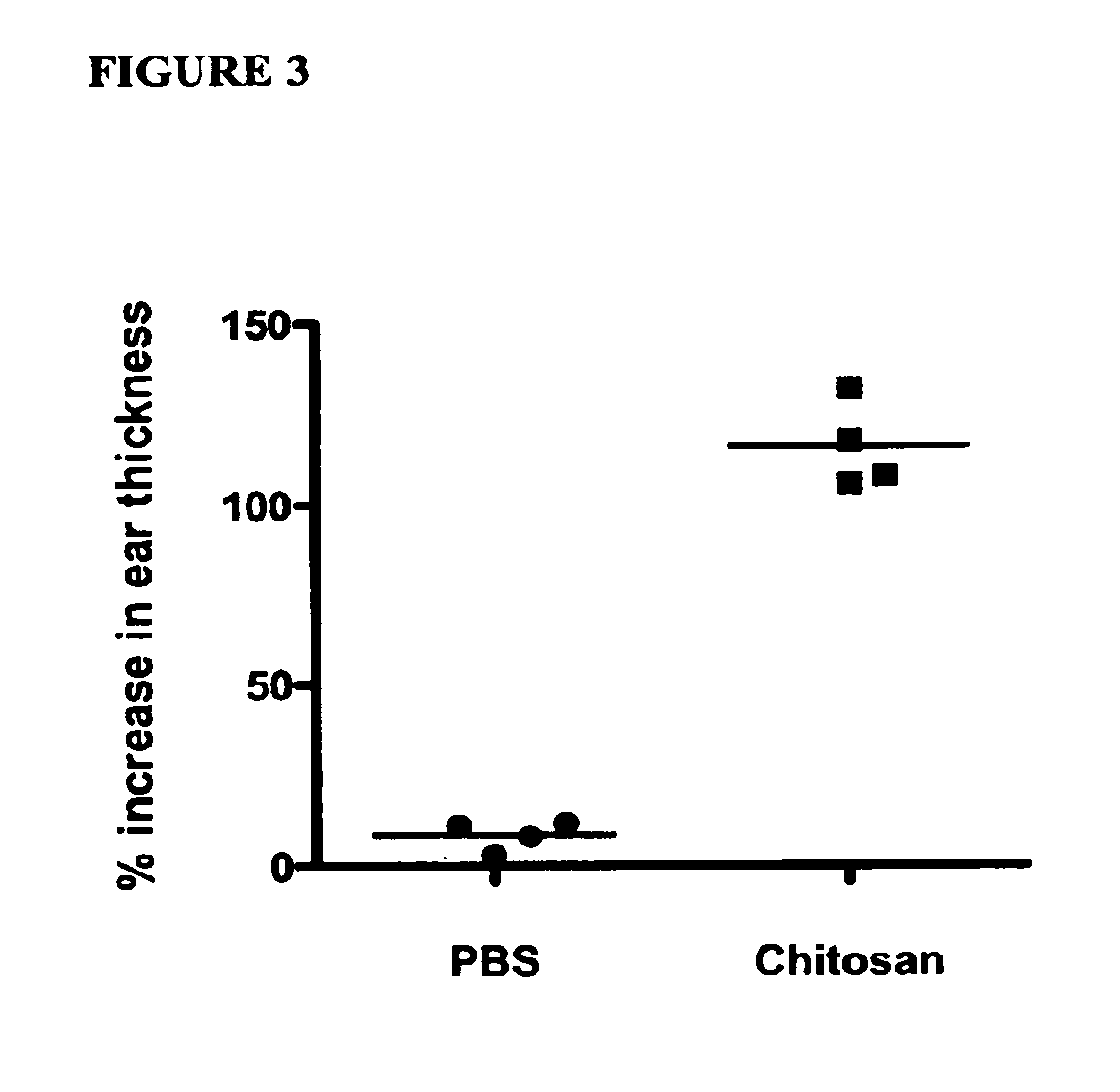Compositions and methods for chitosan enhanced immune response
a technology of immune response and composition, applied in the field of composition and methods of chitosan enhanced immune response, can solve the problems of chitosan solution alone not being tested as a vaccine delivery system or depot for subcutaneous administration, chitosan has never been used as a vaccine delivery system or depot, and the mucoadhesive advantage of chitosan is lost during non-mucosal administration, so as to increase the cell mediated immune response and increase the cell
- Summary
- Abstract
- Description
- Claims
- Application Information
AI Technical Summary
Benefits of technology
Problems solved by technology
Method used
Image
Examples
example 1
Chitosan Enhanced Both Humoral and Cell-Mediated Vaccine Responses
[0190]C57BL / 6 mice were vaccinated subcutaneously with a model antigen, beta-galactosidase, in either PBS or chitosan solution. Proliferation of CD4+ splenocytes from mice receiving the vaccine in chitosan is significantly greater (P+ splenocytes from mice receiving the vaccine in PBS when re-exposed to the vaccine antigen, as shown in FIG. 1. Chitosan also increased serum IgG titers to beta-galactosidase (FIG. 2a). Antibody titers in mice administered beta-galactosidase in chitosan were increased 5.3 fold, as linearly approximated at an optical density of 1.0. Similarly, chitosan enhanced antigen-specific IgG1 and IgG2a titers 5.9- and 8.0-fold respectively, implying a mixed TH1 / TH2 response (FIGS. 2b-c). All increases in antibody titers were statistically significant (P<0.001).
[0191]Delayed-type hypersensitivity responses were measured as an in vivo assay of cell-mediated immune function. One week after the booster ...
example 2
Chitosan was Equipotent to IFA and Superior to Aluminum Hydroxide
[0192]After it was shown that chitosan had vaccine enhancing properties, the next objective was to compare chitosan with the commonly used adjuvants, IFA and aluminum hydroxide. Antigen-specific CD4+ proliferative and serum antibody responses were similar in mice vaccinated with beta-galactosidase in either chitosan solution or IFA, as shown in FIG. 4a-b. Antigen-specific CD4+ proliferative responses were significantly greater (Pa). Chitosan also enhanced antigen-specific antibody titers 6.6-fold over aluminum hydroxide at optical density of 1.0, as shown in FIG. 5b.
example 3
Chitosan Expanded Local Lymph Nodes
[0193]During the aforementioned studies, mice were dissected to note any gross pathological changes that resulted from the subcutaneous (s.c.) injection of chitosan. A significant increase in the size of the lymph nodes draining the s.c. chitosan injections was observed. Mice were otherwise healthy at the time of sacrifice. To characterize the leukocyte expansion, inguinal lymph nodes were resected, disrupted, counted and stained for phenotypic analysis via six-color flow cytometry. The number of leukocytes in inguinal lymph nodes from mice injected with chitosan increased by more than 67% from 4.9×106 leukocytes per node at day 0 to 8.2×106 leukocytes per node at day 14, shown in Table 1, below. Table 1 shows the results of experimentation wherein chitosan, without antigen, was injected subcutaneously at Day 0. Spleens and lymph nodes were harvested at Days 0, 2, 7, 14 and 21. The results in Table 1 show that chitosan increased the number of lymph...
PUM
| Property | Measurement | Unit |
|---|---|---|
| Mass | aaaaa | aaaaa |
| Fraction | aaaaa | aaaaa |
| Fraction | aaaaa | aaaaa |
Abstract
Description
Claims
Application Information
 Login to View More
Login to View More - R&D
- Intellectual Property
- Life Sciences
- Materials
- Tech Scout
- Unparalleled Data Quality
- Higher Quality Content
- 60% Fewer Hallucinations
Browse by: Latest US Patents, China's latest patents, Technical Efficacy Thesaurus, Application Domain, Technology Topic, Popular Technical Reports.
© 2025 PatSnap. All rights reserved.Legal|Privacy policy|Modern Slavery Act Transparency Statement|Sitemap|About US| Contact US: help@patsnap.com



